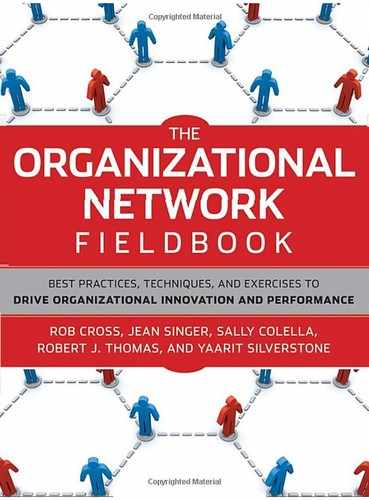11.4. Part 2: Network Perspective and Action Planning
With a better understanding of the strategy, participants were ready to evaluate how their networks would help them to support it and to identify ways in which they needed to alter their networks for the new demands.
11.4.1. Initial Table Introductions
Participants were assigned to new table groups to provide an opportunity for even more connections. Once again, the results of an ONA would have helped us design the most effective seating arrangements.
Again, the session began with some ice-breaker questions:
What is your name and role?
What is your favorite vacation spot?
What is one thing you have achieved inside or outside of work over the past year that makes you proud?
11.4.2. PNA Presentation
We then gave a presentation on the value of a network perspective. Key points included the following:
Research findings linking robust networks to higher individual and organizational performance.
The basics of network analysis: network structures and implications for people who are central, boundary spanners, and peripheral
Instruction on how to read network diagrams
For those companies that conduct an ONA prior to the workshop, this is the time to share key findings, particularly those demonstrating how the current patterns within the group either support or hinder the new strategy.
I then distributed the results of the PNA to each participant.
11.4.3. Interpreting Results of PNA Reports
After participants received their reports, we walked the full group through the PNA and indicated why each section is important and what to look for in their own results. We then instructed individuals to work independently for 20 minutes to review their PNA reports. As they did so, we asked them to consider the following questions about their network, in light of the new vision and strategy for BizTech:
How do the connections I rely on most tend to be similar in various ways—for instance, by type of expertise (product or discipline), hierarchical level, boundary (organization, work group, division), time known, method of communicating, race, gender, age?
What connections do not support my role in the new strategy and therefore deserve less of my time and attention?
What new connections should I develop to support my role in the new strategy? What ideas do I have for developing new relationships? Have I met people today with whom I should stay in touch about work-related issues?
As participants reviewed their reports, the facilitators moved from table to table, answering questions and guiding participants.
11.4.4. Network Action Planning: Paired Coaching Sessions
We then invited individuals to work in pairs for 30 minutes to coach each other on ways to extend their networks to include ties that cross various groups—to bring their networks into alignment with the requirements of the new strategy. We urged each peer coach to challenge his or her partner's thinking and to provide the names of people the partner should get to know. Each member of the pair took 15 minutes to respond to the following questions:
Describe your existing network. What are its strengths? What changes would you like to make?
What are two actions you will take following this workshop to enhance your network and align it to support the new BizTech strategy?
Many participants discovered during this part of the workshop that their networks were insular—that most of their work-related interactions were with members of their immediate teams. One programmer realized that he rarely, if ever, interacted with programmers who worked on different products and so did not understand their perspectives. Many technologists and marketing professionals found that they interacted primarily with others from the same discipline, which limited the development of technology that would truly meet clients' needs. Others found that they were connected mostly with those who had joined the firm at around the same time, particularly those who had been with the company longer than 10 years or less than 1 year.
On the basis of these network conversations, each person created an action plan and began to consider who in the group could help them expand their network.
11.4.5. Closing
We closed the sessions by asking participants to report something they had learned about their role in the new strategy and an action they planned to take in the next week to align their network with the strategy's requirements. In the course of this discussion, the group developed a sense of the aggregate changes that needed to be made. For the most part, these changes related to taking direct action to enhance communication between different disciplines within BizTech.
Following the workshops, we hosted a reception where people continued to get to know one another.
